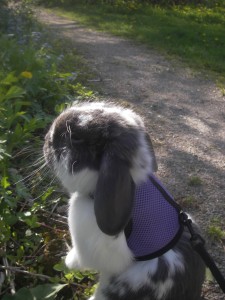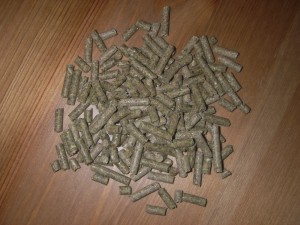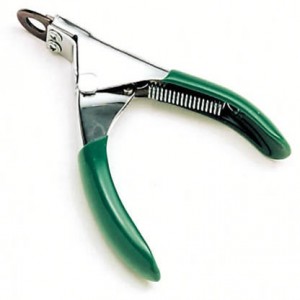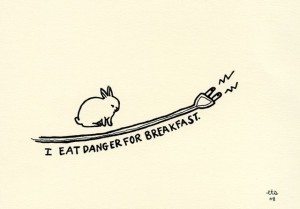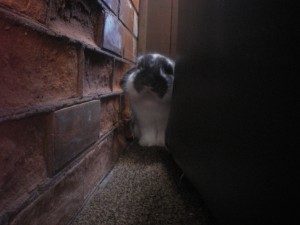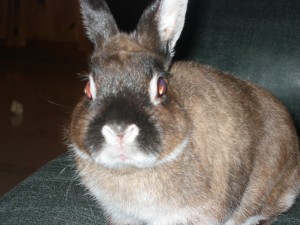Spring is here, Easter is next weekend and adorable bunnies are popping up everywhere you look.
You may be thinking this is a great time to take a real rabbit home, for yourself or as an Easter gift for a child, but before you do, you should consider everything that goes into caring for a happy house hopper.
Feeding
The diet of most rabbits is made up mostly of alfalfa hay pellets. These can be bought from most pet supply stores. I buy my bunny’s pellets from a bulk food store because I find they are cheaper and fresher. However, your rabbit’s diet should not be pellet only, you should frequently offer your furry friend fresh or dried hay, also found at most pet supply stores, or fresh from the field if you are lucky enough to have a farmer in the family like my bunny, as well as, almost any fruit or vegetable you would eat. I say, almost, because there are some fruits and vegetables that you should not feed to your bunny, these include: fruits and vegetables that taste sweet to you and are therefore high in sugar, cabbage, cauliflower and broccoli, which can all give your pet painful gas and carrot tops, collard greens, kale, parsley and spinach which are high in calcium and could cause bladder stones, though they can be fed in moderation.
In the summer, you should aim to feed your rabbit more fresh fruits and vegetables than usual to help them stay hydrated. You can also try running leafy greens under water before feeding them to your bunny to get as much water into them as possible. I put frozen peas and blueberries in my bunny’s dish in the summer to help keep her cool, she is smart enough to not try to eat them until they thaw. Fresh leafy herbs from the garden also make a nice summer treat, and who doesn’t love a bunny with minty fresh breath?
Although it’s adorable to watch, you cannot feed your rabbit people-snacks like cookies, crackers or chips, as treats – they can be quite damaging to your pet’s health. If you offer your bunny a new food and they don’t seem to like it, don’t force them to eat it. Remove the food from their dish if they don’t take an interest in it within the hour. New foods or diet changes should be introduced slowly or your bunny could develop loose stool problems, or what we call, “the hops” in my house.
These rules must be carefully observed because rabbits have a delicate digestive system. You can help your bun keep their digestive tract running smoothly by feeding them fresh, dried or juice forms or either pineapple or papaya regularly. These fruits possess a chemical that breaks up hairballs and other clogs in your bunny that may form from curiously eating things they shouldn’t have.
Your rabbit should always have access to plenty of fresh water.
Grooming
Rabbits shed four times a year with the biggest shed occurring in the early spring. During shedding periods you can really help your bunny out with regular, gentle brushing. I find rubber brushes work best as a bun’s skin is much more sensitive than a cat or dog’s skin. You can also gently tug out loose tufts of fur with your hands. My bunny mats up like nobody’s business and I frequently have to use scissors to break them up. This is a delicate process that needs to be done very carefully, first I try snipping into them perpendicular to her skin and pulling them apart with my hands. If that doesn’t work I then, very carefully, snip them right out. This not only keeps her comfortable, but it also prevents her from working them out herself and swallowing them.
Some bunnies can go their whole lives never needing a bath, mine is a smelly beast that needs about two baths a year. This can be very stressful for the rabbit and so there is a bit of a science to it.
Trimming your pet’s nails is an essential part of grooming and should be done every month or two. Most bunny owners prefer a guillotine style trimmer. Every rabbit responds differently to the nail trimming process, after practice you will learn how to best cut your bun’s nails. My bunny likes to be held by me and trimmed by my fiancé. I hold her close but no tighter than necessary, with one hand supporting her bottom and back feet and the other holding her chest and tummy area. I calm her by speaking softly as my fiancé goes in for the cut. The most important part of cutting your bun’s nails is to not cut into the sensitive quick, the pink line inside the nail, because this can be very painful and traumatizing for your pet. While you are learning and gaining confidence it is better to leave the nails a little long than to cut them too short.
Exercise
You need to let your rabbit out of cage for exercise for at least one hour everyday. Bunnies are smarter than you think; they need lots of exercise, entertainment and stimulation to avoid boredom, which can cause them to become destructive. The longer they can get out everyday the better, but they need to be supervised.
Rabbit Proofing
If there is a danger in your house, your rabbit will find it.
They like hiding and playing in dark hidden places like under couches and beds or duct work. These places can be dangerous if the bunny chews and swallows or climbs inside the furniture. If you cannot block or restrict access to these places you should check for chewing regularly.
Bunnies love chewing wires, this is very risky behaviour as the bunny can be burned or electrocuted. This can be prevented by wiring your house with your bunny in mind, putting wires under the carpet, buying special tubing to wrap around the wires or doing what my fiancé does and taping the wires down and maintaining them regularly since our bunny loves to pull the tape up.
Rabbits can jump higher that you think, you need to make sure they cannot reach any unstable surfaces. Even my little Holland Lop can jump high enough to get onto the dining table. If they can get to them, rabbits will nibble your house plants, many of which are toxic. Any object that could hurt your rabbit, lit candles for example, need to be put out of reach.
If a certain room cannot be bunny proofed, ours’ is our bedroom, restrict your bun’s access to that room by closing the door or using a baby gate while your bunny is out.
Summer Heat
Rabbits do not handle heat well. In the summer you need to monitor your pet closely to make sure they stay comfortable, keep their cage in a shaded, naturally cool part or your home (not in front of an air conditioner), keep them hydrated and let them out during the hottest part of the day so they can find a cool place on their own. I don’t have air conditioning so I keep my bun cool by freezing two water bottles and alternate placing them in her cage on really hot days.
Cage
Your bunny’s cage needs to be placed in a quiet, peaceful spot in your house, but this spot cannot be completely isolated because these social creatures don’t like being too far away from the family. I keep my Sophie Buns in the kitchen and greet her every time I’m in there.
The cage you choose for your bunny should be big enough for a litter box, dish, some toys and provide enough space for your bun to stand up and stretch out lying down. It should have a door that your rabbit can walk out through on his or her own, when open. Your bunny should be able to see out of their cage, this can be hard for smaller rabbits in plastic bottom models with high sides. Your rabbit’s cage should not have solid walls.
Housebreaking
People are always impressed when I tell them that I have a litter box trained rabbit, but it’s not that big of a feat to accomplish. All you have to do is find out which corner of the cage, or your house, the rabbit likes to its bunny business in and put a litter box there. The bunny will simply start using it obediently. After a few months of regular use, you can move the litter box to a different corner and your bunny should continue to use it.
Many pet supply stores sell special litters rabbit use that are very similar to cat litter but they can be expensive. My bunny and I didn’t care much for them anyway so now I use a litter, made and marketed towards cats, made from recycled newspaper called Yesterday’s News. I find it performs very well and it’s safer if she feels compelled to nibble it.
Reading Your Rabbit
Although rabbits don’t communicate with you using noise, they don’t hold anything back with their body language. When your bun is happy or excited, they will do the cutest thing, jumping up in the air, kicking their feet and making other seemingly uncontrollable movements. When they are angry with you or scared, they will loudly thump their big back feet on the floor. These happy jumps and angry thumps are just some of the many messages you will learn to read from your rabbit.
Rabbits and Children
Many people think that rabbits will be an easy pet and good pet to start with for a child. This is not true. Rabbits, although cute and fluffy, are a lot of work. I spend twice as much time in a day caring for my rabbit’s needs than I do caring for my demanding, spoiled cat. As for how well a rabbit will get along with a child, you have to remember that every rabbit is different; some will have a personality and disposition that agrees with children and others will not. My childhood rabbit was very docile, sweet and easy going, perfect for a child, he even used to let my little brother poke him in the eyes, but the rabbit I have now, although loving, is stubborn, energetic and hates being touched unless it is on her terms – sit on the floor and she’ll climb all over you, but try to pet her and she’ll run away. She would not be a good pet for a child as they would have a hard time understanding this behaviour. A rabbit’s personality can be a bit of a wild card, and that personality can be greatly shaped by how much love and care you give them, they are not an easy pet that can be put in a cage and forgotten, don’t get me wrong, they are great pets for adults and children alike, but they should never be solely the responsibility of a child.
If a rabbit is right for your family, consider adopting a homeless bunny from one of the wonderful rabbit rescues operating today. They animals are usually given up by people who purchased them under incorrect knowledge and expectations. Sadly, rabbit rescues are busy this time of year do to all of the people who unwisely give them as Easter gifts, only to give them away, or extremely unwisely, release into the wild when they grow up. Don’t worry about adopting an older rabbit, they can live up to eight to twelve years, my childhood bunny, Eric, as well as the famous Cinnamon, have lived to the ripe old age of thirteen. You can even spay or neuter a rabbit, which is highly recommended if you plan to give a home to more than one.

